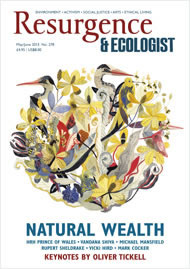Why hasn’t the apocryphal super-advanced civilisation of extra-terrestrials contacted us? One rather ominous answer is that on reaching the stage of being able to alter its planetary environment, it inadvertently initiates its own demise. Or, as expressed by environmentalist Senator Bob Brown (Australia’s first green politician), “That’s why they are not communicating with Earth. They have ‘extincted’ themselves. They have come and gone, and now it’s our turn.”
This is one of the more alarming considerations likely to engage us in this new book of big ideas – ideas rooted in the experience of the book’s 11 diverse contributors, who explain the origin of their belief systems, or (in contemporary colloquial parlance) where they are coming from.
The collection begins with a heart-warming cameo of the twenty-something Satish Kumar, whose shock at learning of peace activist Bertrand Russell’s imprisonment prompted the remarkable and ambitious idea of walking to the world’s four ‘nuclear capitals’. During this 8,000-mile trek as a peace pilgrim, Satish witnessed the extent of humankind’s environmental depredations – spurring him on to expand his raison d’être to encompass eco-activism.
Just as Satish inspired many people through talks subsequent to his Herculean foot journey, so Franny Armstrong has reached out to multiple audiences via her independent films, perhaps most notably The Age of Stupid. Set in an imaginary, devastated world of 2055, it forms a sorrowful retrospective of the global environmental catastrophes that characterised the previous 100 years.
Our age qualifies as uniquely stupid because, unlike previous generations, not only are we aware of anthropogenic climate change and how to ameliorate it, but, faced with the critical challenges to our planet’s future habitability, our relative inaction and inertia are simply extraordinary.
Tim Flannery, Australia’s first chief climate change commissioner, provides a captivating account of the influences on his life, beginning with his childhood in a Melbourne suburb, where he watched the bulldozing of his informal natural playground, a copse of native ti-trees. This piece of municipal ecocide rendered him wary thereafter of those who championed such changes in the name of progress, and strongly affected his life’s outlook.
And it was similar thoughts to these that led Polly Higgins to realise that the planet needed a good lawyer. Despite a proliferation of laws purporting to protect our planet, it still suffers massive destruction in regions such as the Amazon rainforest and the Athabasca tar sands of Canada. She persuasively reasons that just as we have laws against killing one person (homicide), or a group of people (genocide), there should be an international law protecting the Earth’s right to life: ecocide.
Humankind’s treatment of the planet has also been the focus of environmental writer Bill McKibben, who is especially insightful in his analysis of the global power imbalance between the environmental movement and the fossil-fuel industry, represented by eight of the world’s ten largest multinationals. In one section of searing clarity he points out why green activists are not the real radicals: “It’s oil and coal and gas barons who are radical: they’re willing to fundamentally alter the chemical composition of the atmosphere in order to make more money.”
Planetary respect also forms a central theme of Vandana Shiva’s clarion call for resistance to genetically modified seed monopolies and patents, her Gandhian approach manifested through the Navdanya movement, comprising “a non-violent, non-cooperation with laws that claim seed is a corporate invention” – an insidious development quite reasonably described as ‘biopiracy’.
The moral strength of her argument is supported by some disturbing details, such as the 95% of cotton seed in India now accounted for by Monsanto’s genetically engineered Bt cotton, or the quarter of a million suicides amongst India’s farmers.
The selection of contrasting voices in Small World Big Ideas speak to us of their diverse strivings, not only to ameliorate the many harms we bring upon the Earth and its people, but also to show how things could, and should, be different. Their inspirational accounts are by turns sobering, poignant or vexing, but rarely dull or mundane.
For those aware of its big ideas but less familiar with the activists promoting them, this collection is recommended reading. However, for those only peripherally conscious of the issues affecting their futures, it is essential.








